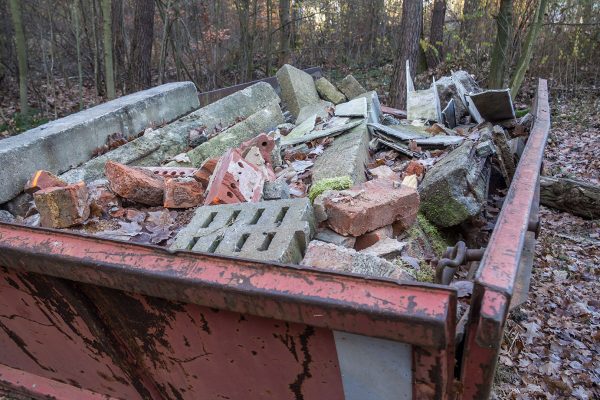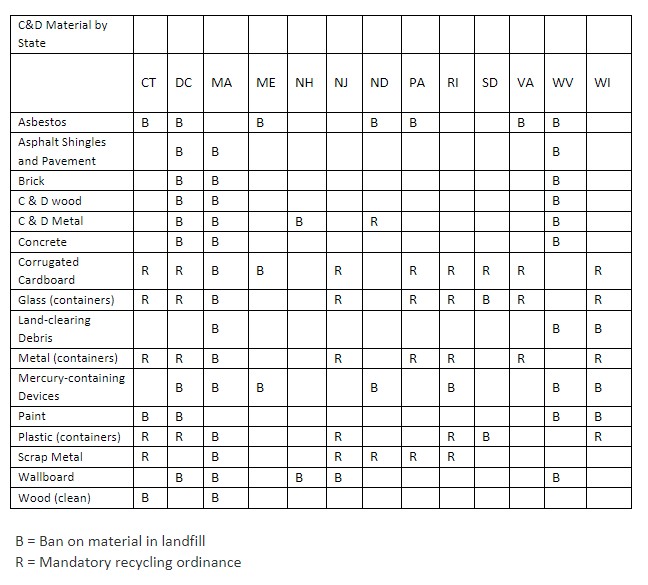When many Mainers think about waste, their minds often wander to trash that they throw out at home or work. However, there is another culprit that is quickly filling up our landfills and harming residents of Maine. Construction and demolition debris (CDD), such as scrap metal, concrete, and wood, which is created from the tearing down of buildings makes up approximately 52% of the waste landfilled in Maine.

Most of Maine’s CDD waste ends up at Juniper Ridge Landfill, a large, State-owned landfill located in Old Town. The Natural Resources Council of Maine (NRCM) worked with our partners to pass a new law, LD 1639,that closes a loophole in the state’s waste laws that had allowed private corporations to import construction and demolition waste from across New England and dump it in Maine.
Now that the out-of-state waste loophole is closed, the focus is on finding new ways to recycle and reuse CDD waste created in Maine so that less of it is landfilled. By reducing the amount of CDD material put into the landfill, we can work to extend the life of this landfill and reduce the potential health impacts on nearby residents and the Penobscot Nation. In 2019, Maine produced 469,719 tons of CDD total. Only 2.47% of this debris was actually recycled, with 440,336 tons going to fill up our State-owned landfill. By comparison, 403,644 tons of municipal solid waste were disposed of in landfills in 2019, with 1,357,290 tons produced total. Thus, construction and demolition debris is a more significant contributor to landfills than residential trash, even though there is actually less CDD waste overall.
As of now, Maine only restricts three materials from being landfilled: asbestos, corrugated cardboard, and mercury-containing devices. This means we have a lot of room for improvement when it comes to reducing the amount of CDD waste going into our landfills.
The majority of materials used in construction could be recycled. Concrete can be crushed or pulverized and then used as a base for new asphalt, pavement for hard outdoor surfaces, or other uses. Bricks can be chipped and used in landscapes, substituting for sand, or be created into new bricks.
Not only does reducing the disposal of construction and demolition materials benefit the environment, but it is also beneficial to the people living nearby by minimizing the pollution that can enter the land and water near the landfills. Prohibiting certain types of CDD waste from being disposed of in landfills can also save construction companies money. For example, recycling construction materials means that companies do not have to pay for new materials and can reuse or repurpose materials that are already located on site. In certain circumstances, materials made out of recycled waste can actually be better quality than those that are made with new materials. For those looking to recycle CDD waste, the Construction and Demolition Recycling Association provides a list of CDD recycling areas near where you live.
Other places in the United States already have successful comprehensive construction and demolition debris bans on certain materials. Massachusetts, West Virginia, and the District of Columbia currently have comprehensive bans in place banning asphalt, brick, concrete, and metal from entering landfills. In placing these bans, they significantly reduce the amount of debris in landfills, reduce demand for new construction materials, and can save construction companies money all while benefiting those living nearby landfills.

This fall, the Legislature’s Environment & Natural Resources Committee will be holding several meetings to evaluate solutions that Maine can take to reduce the landfilling of CDD materials and increase our state’s CDD recycling rate. NRCM’s team will be participating and plans to share updates as more information and policy emerges. We encourage you to sign up for our action alerts so you’ll know if there is an opportunity to make your voice heard.
—by Jane Hirschman, NRCM Policy Intern











Leave a Reply